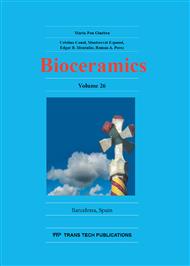p.283
p.289
p.295
p.300
p.306
p.315
p.321
p.326
p.332
Investigating Approaches for Three-Dimensional Printing of Hydroxyapatite Scaffolds for Bone Regeneration
Abstract:
This study investigated the feasibility of manufacturing hydroxyapatite (HA)-based scaffolds using 3D printing technology by incorporating different binding additives, such as maltodextrin and polyvinyl alcohol (PVOH), into the powder formulation. Different grades of PVOH were evaluated in terms of their impact on the printing quality. Results showed that scaffolds with high architectural accuracy in terms of the design and excellent green compressive strength were obtained when the PVOH (high viscosity) was used as the binding additive for HA.
Info:
Periodical:
Pages:
306-311
Citation:
Online since:
November 2014
Authors:
Price:
Сopyright:
© 2015 Trans Tech Publications Ltd. All Rights Reserved
Share:
Citation:


